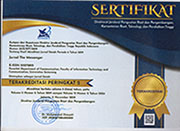The Representation of Prophetic Messages in Folklore of Tegal Regency
Abstract
Statement of the problem in this research was The Representation of Prophetic Messages in Folklore of Tegal Regency . Long time ago, folklore was used as a medium of communication between parents and their children in teaching Javanese values. Here are some messages and values in every folklore delivered in communities constructed particular character building in every communities. That message has mediated social and transcedental dimensions, it is well known as prophetical ethics which enhance humanization, liberalization, and transcendence. This research was qualitative approach regarding the description. Several studies related to substance of folklore have been conducted by some researchers are Duija (2005), Martinoska (2005), Lukin (2008), Hukantaival (2012), Galieva (2015), Taylor (2003), and Malik (2018).
Keywords
Full Text:
PDFReferences
Bafadal, F.A. & Saefullah, A. (2006). Naskah Klasik Keagamaan Nusantara: Cerminan Budaya Bangsa. Departemen Agama RI, Badan Litbang Agama Dan Diklat Keagamaan, Puslitbang Lektur Keagamaan, 2.
Duija, I. N. (2005). Tradisi Lisan, Naskah, dan Sejarah Sebuah Catatan Politik Kebudayaan. Wacana: Journal of Humanities of Indonesia, 7(2), 115 128.
Efendi, A. (2012). Realitas Profetik dalam Novel Ketika Cinta Bertasbih karya Habiburrahman El-Shirazy. Jurnal Litera, 11(1), 72 82.
Galieva, M. A. (2015). Myths and Folklore in the Picture of the World in the Epoch of Avant-Garde: Statement of the Problem. Historical and Social Educational Idea s, 31 36.
Handayani, S. (2016). Menggapai Permainan Tradisional Anak Indonesia dalam Perangkat berbasis Android. Jurnal The Messenger, 8(2), 61 67.
Hukantaival, S. (2012). Finding Folk Religion: An Archaeology of Strange Behaviour. Journal of Folklore, 55, 105.
Koentjaraningrat. (1984). Kebudayaan, Mentalitas, dan Pembangunan. Jakarta: Gramedia Pustaka Utama.
Kuntowijoyo. (2005). Maklumat Sastra Profetik. Horizon, 24(5).
Lukin, K. (2008). Nenets Folklore in Russian: The Movement of Culture in Forms and Languages. Journal of Ethnology and Folkloristics, 2(1), 67 82.
Mahsun. (2007). Metode Penelitian Bahasa. Jakarta: PT. Raja Grafindo Persada.
Malik, A. (2018). Cultural Identity and Social Interaction of Indigenous Peoples in the Middle of Modernization. Jurnal The Messenger, 10(1), 34 43.
Martinoska, A. (2005). Ethnic Stereotypes in the Macedonian Folklore and Their Reflection in the Macedonian Contemporary Literature. Journal of Neohelicon, 32(1), 71 79.
Masbur. (2016). Integrasi Unsur, Humanisasi, Liberasi dan Transendensi dalam Pendidikan Agama Islam. Jurnal Edukasi, 2(1), 44 59.
Moleong, L. J. (2010). Metodologi Penelitian Kualitatif. Bandung: PT. Remaja Rosdakarya.
Qomariyah, U. (2015). Membaca Empat Novel Habiburrahman El-Shirazy: Internalisasi Pengembangan Nilai Profetik Berbasis Karakter. In Prosiding I Seminar Internasional Bahasa, Sastra, dan Pembelajarannya: Pengembangan Nilai-nilai Profetik dalam Kehidupan Berbangsa melalui Bahasa, Sastra, dan Pembelajarannya. Malang: Universitas Muhammadiyah Malang.
Rochani, A. H. (2014). Babad Negari Tegal. Tegal: Dinas Pendidikan dan Kebudayaan.
Taylor, P. (2003). The Goddess, the Etnologist, the Folklorist and the Cadre: Situating Exegesis of the Vietnam s Folk Religion in Time and Place. The Australian Journal of Antrophology, 14(3), 383 401.
Tebba, S. (2008). Filsafat dan Etika Komunikasi. Tangerang: Pustaka Irvan.
Trianton, T. (2015). Strategi Pemertahanan Identitas dan Diplomasi Budaya melalui Pengajaran Sastra Etnik bagi Penutur Asing. Konferensi Bahasa dan Sastra III Universitas Sebelas Maret.
Zahavi, D. (2008). Internalism, Externalism, and Transcendental Idealism. Journal of Synthese, 160(3), 355 374.
Zubaedy, A. (2014). Babad Tegal. Tegal: Dinas Pendidikan dan Kebudayaan.
DOI: http://dx.doi.org/10.26623/themessenger.v10i2.781
Refbacks
- There are currently no refbacks.
Copyright (c) 2018 Jurnal The Messenger
View My Stats [Jurnal The Messenger] is an International Scientific Journal, Published by the Department of Communication, Faculty of Information Technology and Communication, Universitas Semarang (Central Java, Indonesia). It is licensed under a Creative Commons Attribution 4.0 International License.



_11.jpg)




_BARCODE.jpg)
_BARCODE1.jpg)


5.png)










2.png)





